Characterization of Pliocene Biogenic Gas Reservoirs from the Western Black Sea Shelf (Romanian Offshore) by Integration of Well Logs and Core Data
Abstract
:1. Introduction
2. Geological Setting and Hydrocarbon Systems
3. Well Logging Programs and Core Measurements Data
4. Data Interpretation Methodology
4.1. Petrophysical Interpretation of Well Logging Data
4.1.1. Pre-Interpretation/Preliminary Processing of Well Logs
4.1.2. Quantitative Interpretation of Well Logs
4.2. Wireline Formation Pressure Data Processing and Analysis
4.3. Permeability Modeling
5. Results and Discussion
5.1. Formation Waters
5.2. Petrophysical Interpretation
5.3. Fluid Contacts
6. Conclusions
- The integration of core measurements in the well log interpretation methodology had a major impact on the validity of the obtained results. Core-derived petrophysical measurements were used both as input computation parameters and also to check and validate the main reservoir parameters resulted from the interpretation (ϕ, Sw, K). Additionally, the core-derived ρma and m provided the necessary constraints for the realistic estimation of Rw from resistivity–porosity dependencies;
- The approach used for Rw estimation, i.e., the use of resistivity–porosity dependencies and the extension of the analysis interval to segments of Pliocene deposits above the gas-bearing reservoirs, proved to be effective. The capability of Rt–ϕ dependencies to reveal linear data trends in clean water-bearing formations with constant Rw showed that parts of the Dacian reservoirs (the very limited bottom water zones underneath the gas columns) and the adjacent post-reservoir Pliocene sections host similar formation waters. This allowed the determination of realistic Rw values, which were used for Sw evaluation in the analyzed wells;
- Particularly in the “B” field, the Laterolog (DLL and HALS) resistivity curves are likely suppressed to varying degrees in each well, leading to possible Sw overestimation and Sh underestimation and negatively impacting gas reserve evaluation. One cause of this problem may be represented by the alternance of thin (millimeter to decimeter thick) resistive and conductive layers of sand and mudstone/shale, which are averaged by the resistivity tools due to their limited vertical resolution;
- An additional source of resistivity logs suppression, both in “A” and in “B” fields, is represented by a high content of capillary-bound water, probably trapped in the small pores of silt intervals. The NMR logging performed in well A-2 from field “A” was essential for understanding the cause of these low-resistivity intervals, sometimes located at the top of resistive gas-bearing reservoirs sands;
- The estimation of GWC depths using formation pressure surveys (frequently considered the main and preferred source of data for defining the fluid contacts) should always be checked and validated using the well log interpretation results. There is a significant degree of uncertainty in using the hydrostatic pressure trends identified in the analyzed wells to estimate the fluid contact position, due to the possibility that the pressures read by the wireline testers are not representative of formation water and gas, but might reflect mixtures of water (or mud filtrate) and gas in various ratios. The NMR log recorded in well A-2 provided valuable insight into the intervals with free fluids and with bound (immobile) water and allowed an assessment of the pressure-derived GWC validity;
- The well log interpretation results indicate that the Dacian reservoirs from fields “A” and “B” cannot be treated as single units, because they include two distinct reservoir intervals separated by permeability barriers of various thicknesses. Consequently, separate fluid contacts should be considered for each reservoir interval, instead of a single GWC obtained from the pressure gradients analysis.
Author Contributions
Funding
Data Availability Statement
Acknowledgments
Conflicts of Interest
References
- Robinson, A.; Spadini, G.; Cloetingh, S.; Rudat, J. Stratigraphic evolution of the Black Sea: Inferences from basin modelling. Mar. Pet. Geol. 1995, 12, 821–835. [Google Scholar] [CrossRef]
- Robinson, A.G.; Rudat, J.H.; Banks, C.J.; Wiles, R.L.F. Petroleum geology of the Black Sea. Mar. Pet. Geol. 1996, 13, 195–223. [Google Scholar] [CrossRef]
- Moroşanu, I.C. Extensional Tectonics in the Tertiary of the Black Sea Shelf—Romanian Offshore. Geo-Eco-Marina 1998, 3, 153–158. [Google Scholar]
- Moroşanu, I.C. Romanian Continental Plateau of the Black Sea: Tectonic-Sedimentary Evolution and Hydrocarbon Potential; Oscar Print: Bucharest, Romania, 2007; 176p, ISBN 978-973-668-167-X. [Google Scholar]
- Moroşanu, I.C. The hydrocarbon potential of the Romanian Black Sea continental plateau. Rom. J. Earth Sci. 2012, 86, 91–109. [Google Scholar]
- Dinu, C.; Wong, H.K.; Ţambrea, D.; Maţenco, L. Stratigraphic and structural characteristics of the Romanian Black Sea shelf. Tectonophysics 2005, 410, 417–435. [Google Scholar] [CrossRef]
- Bega, Z.; Ionescu, G. Neogene structural styles of the NW Black Sea region, offshore Romania. Lead. Edge 2009, 28, 1082–1089. [Google Scholar] [CrossRef]
- Crânganu, C.; Villa, M.A.; Şaramet, M.; Zakharova, N. Petrophysical Characteristics of Source and Reservoir Rocks in the Histria Basin, Western Black Sea. J. Pet. Geol. 2009, 32, 357–372. [Google Scholar] [CrossRef]
- Georgiev, G. Geology and Hydrocarbon Systems in the Western Black Sea. Turkish J. Earth Sci. 2012, 21, 723–754. [Google Scholar]
- Tari, G.; Bega, Z.; Fallah, M.; Kosi, W.; Krézsek, C.; Schléder, Z. The opening of the Western Black Sea Basin: An overview. In Proceedings of the 19th International Petroleum and Natural Gas Congress and Exhibition of Turkey, Ankara, Turkey, 15–17 May 2013. [Google Scholar] [CrossRef]
- Nikishin, A.M.; Okay, A.I.; Tüysüz, O.; Demirer, A.; Amelin, N.; Petrov, E. The Black Sea basins structure and history: New model based on new deep penetration regional seismic data. Part 1: Basins structure and fill. Mar. Pet. Geol. 2015, 59, 638–655. [Google Scholar] [CrossRef]
- Nikishin, A.M.; Okay, A.; Tüysüz, O.; Demirer, A.; Wannier, M.; Amelin, N.; Petrov, E. The Black Sea basins structure and history: New model based on new deep penetration regional seismic data. Part 2: Tectonic history and paleogeography. Mar. Pet. Geol. 2015, 59, 656–670. [Google Scholar] [CrossRef]
- Oaie, G.; Seghedi, A.; Rădulescu, V. Natural marine hazards in the Black Sea and the system of their monitoring and real-time warning. Geo-Eco-Marina 2016, 22, 5–28. [Google Scholar]
- Boote, D.R.D. The geological history of the Istria ‘Depression’, Romanian Black Sea shelf: Tectonic controls on second-/third-order sequence architecture. In Petroleum Geology of the Black Sea; Special Publications; Simmons, M.D., Tari, G.C., Okay, A.I., Eds.; Geological Society: London, UK, 2018; Volume 464, pp. 169–209. [Google Scholar]
- Niculescu, B.M.; Andrei, G. Formation evaluation challenges in Pliocene gas-bearing reservoirs from the Romanian Western Black Sea shelf. E3S Web Conf. 2018, 66, 01004. [Google Scholar] [CrossRef]
- Babskow, A.; Băleanu, I.; Popa, D.; Platon, V.; Mănescu, A. Results Concerning the Use of Seismic and Well Log Data for Defining the Geological Model of the Productive Structures on the Romanian Continental Shelf of the Black Sea. In Proceedings of the AAPG International Convention and Exposition Meeting, Nice, France, 10–13 September 1995. [Google Scholar]
- Riedel, M.; Freudenthal, T.; Bergenthal, M.; Haeckel, M.; Wallmann, K.; Spangenberg, E.; Bialas, J.; Bohrmann, G. Physical properties and core-log seismic integration from drilling at the Danube deep-sea fan, Black Sea. Mar. Pet. Geol. 2020, 114, 104192. [Google Scholar] [CrossRef]
- Stephenson, R.; Schellart, W.P. The Black Sea back-arc basin: Insights to its origin from geodynamic models of modern analogues. In Sedimentary Basin Tectonics from the Black Sea and Caucasus to the Arabian Platform; Special Publications; Sosson, M., Kaymakci, N., Stephenson, R.A., Bergerat, F., Starostenko, V., Eds.; Geological Society: London, UK, 2010; Volume 340, pp. 11–21. [Google Scholar]
- Săndulescu, M. Geotectonics of Romania; Technical Publishing House: Bucharest, Romania, 1984; 336p. (In Romanian) [Google Scholar]
- Săndulescu, M. Structure and Tectonic History of the Northern Margin of Tethys between the Alps and the Caucasus. In Evolution of the Northern Margin of Tethys: The Results of IGCP Project 198; Rakus, M., Dercourt, J., Nairn, A.E.M., Eds.; Société géologique de France: Paris, France, 1989; pp. 3–16. [Google Scholar]
- Mutihac, V. Geological Structure of the Romanian Territory; Technical Publishing House: Bucharest, Romania, 1990. (In Romanian) [Google Scholar]
- Bateman, R.M. Openhole Log Analysis and Formation Evaluation, 2nd ed.; Society of Petroleum Engineers: Richardson, TX, USA, 2012; 653p, ISBN 978-1-61399-269-2. [Google Scholar]
- Klinkenberg, L.J. The permeability of porous media to liquids and gas. In Proceedings of the Drilling and Production Practice, New York, NY, USA, 1 January 1941; paper API-41-200. pp. 200–213. [Google Scholar]
- Archie, G.E. The Electrical Resistivity Log as an Aid in Determining Some Reservoir Characteristics. Trans. Am. Inst. Min. Metall. Pet. Eng. 1942, 146, 54–62. [Google Scholar] [CrossRef]
- Schlumberger Ltd. Log Interpretation Principles/Applications; Schlumberger Educational Services: Houston, TX, USA, 1991. [Google Scholar]
- Hingle, A.T. The use of logs in exploration problems. In Proceedings of the SEG 29th International Annual Meeting, Los Angeles, CA, USA, 9–12 November 1959. [Google Scholar]
- Asquith, G.; Krygowski, D. Basic Well Log Analysis, 2nd ed.; AAPG: Tulsa, OK, USA, 2004; 244p, ISBN 0-89181-667-4. [Google Scholar]
- Pickett, G.R. Pattern Recognition as a Means of Formation Evaluation. Log Anal. 1973, 14, 3–11. [Google Scholar]
- Coates, G.R.; Xiao, L.; Prammer, M.G. NMR Logging Principles and Applications; Halliburton Energy Services: Houston, TX, USA, 1999; 235p. [Google Scholar]
- Mao, Z.Q.; Xiao, L.; Wang, Z.N.; Jin, Y.; Liu, X.G.; Xie, B. Estimation of permeability by integrating nuclear magnetic resonance (NMR) logs with mercury injection capillary pressure (MICP) data in tight gas sands. Appl. Magn. Reson. 2013, 44, 449–468. [Google Scholar] [CrossRef]
- Spooner, P. Lifting the Fog of Confusion Surrounding Clay and Shale in Petrophysics. In Proceedings of the SPWLA 55th Annual Logging Symposium, Abu Dhabi, United Arab Emirates, 18–22 May 2014. paper SPWLA-2014-VV. [Google Scholar]
- Schlumberger Ltd. Log Interpretation Charts; Schlumberger Ltd.: Houston, TX, USA, 2013; ISBN 978-1-937949-10-5. [Google Scholar]
- Serra, O. Well Logging and Reservoir Evaluation; Editions Technip: Paris, France, 2007; ISBN 978-2-7108-0881-7. [Google Scholar]
- Poupon, A.; Leveaux, J. Evaluation of water saturation in shaly formations. Log Anal. 1971, 12, 3–8. [Google Scholar]
- Heslop, A. Gamma-ray log response of shaly sandstones. In Proceedings of the SPWLA 15th Annual Logging Symposium, McAllen, TX, USA, 2–5 June 1974. paper SPWLA-1974-M. [Google Scholar]
- Katahara, K.W. Gamma Ray Log Response in Shaly Sands. Log Anal. 1995, 36, 50–56. [Google Scholar]
- Ellis, D.W.; Singer, J.M. Well Logging for Earth Scientists, 2nd ed.; Springer: Dordrecht, The Netherlands, 2008; 692p, ISBN 978-1-4020-4602-5. [Google Scholar]


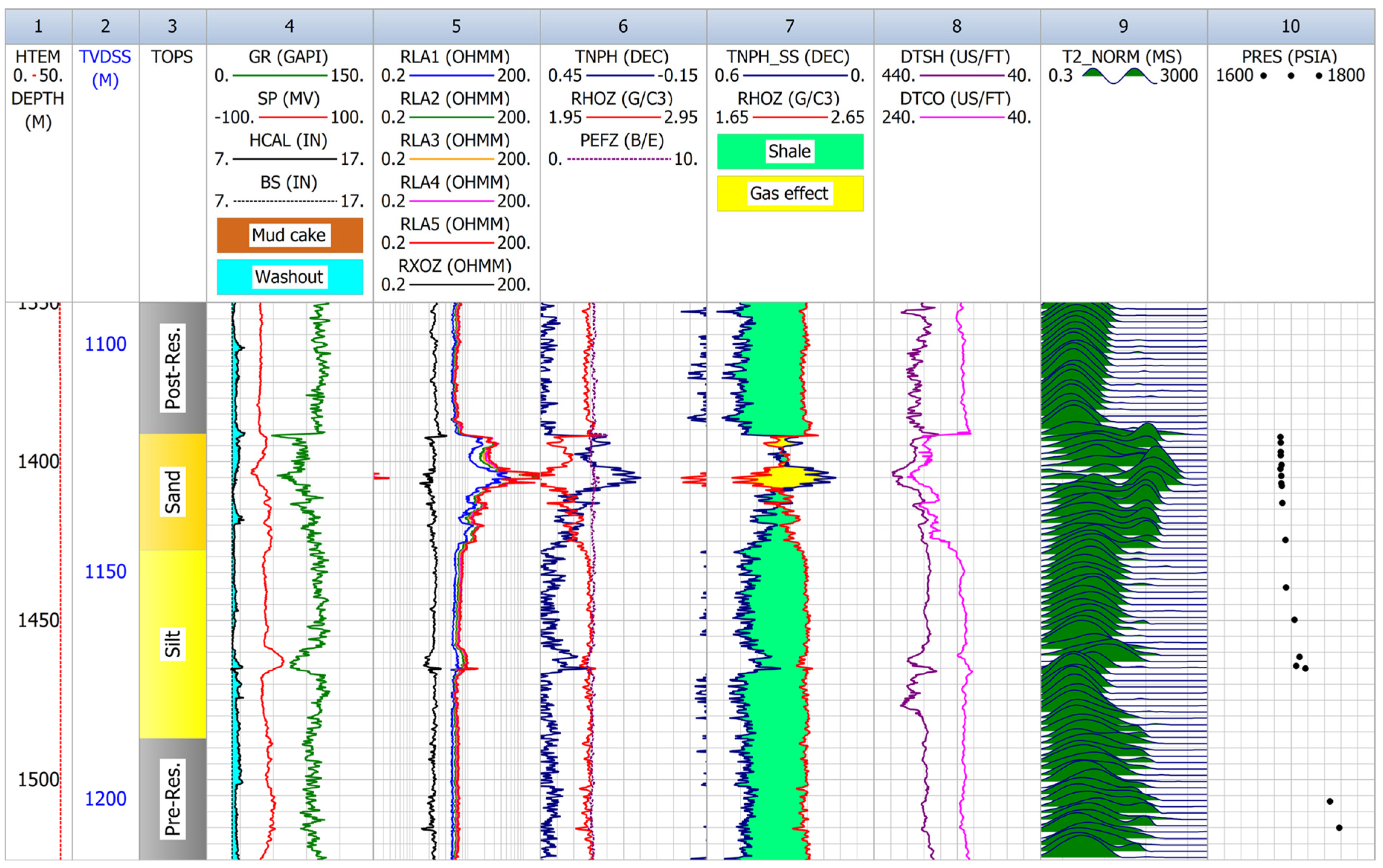
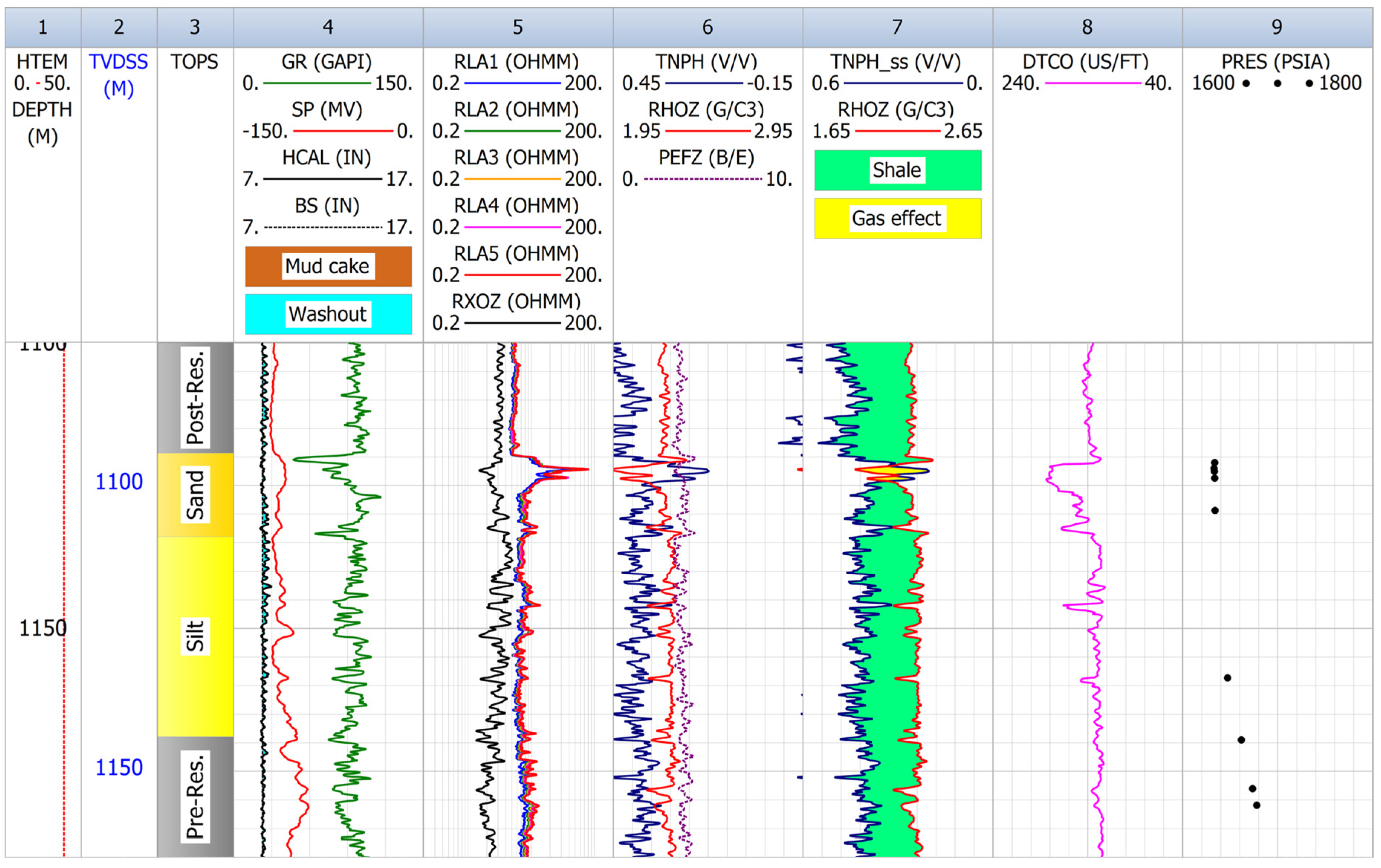


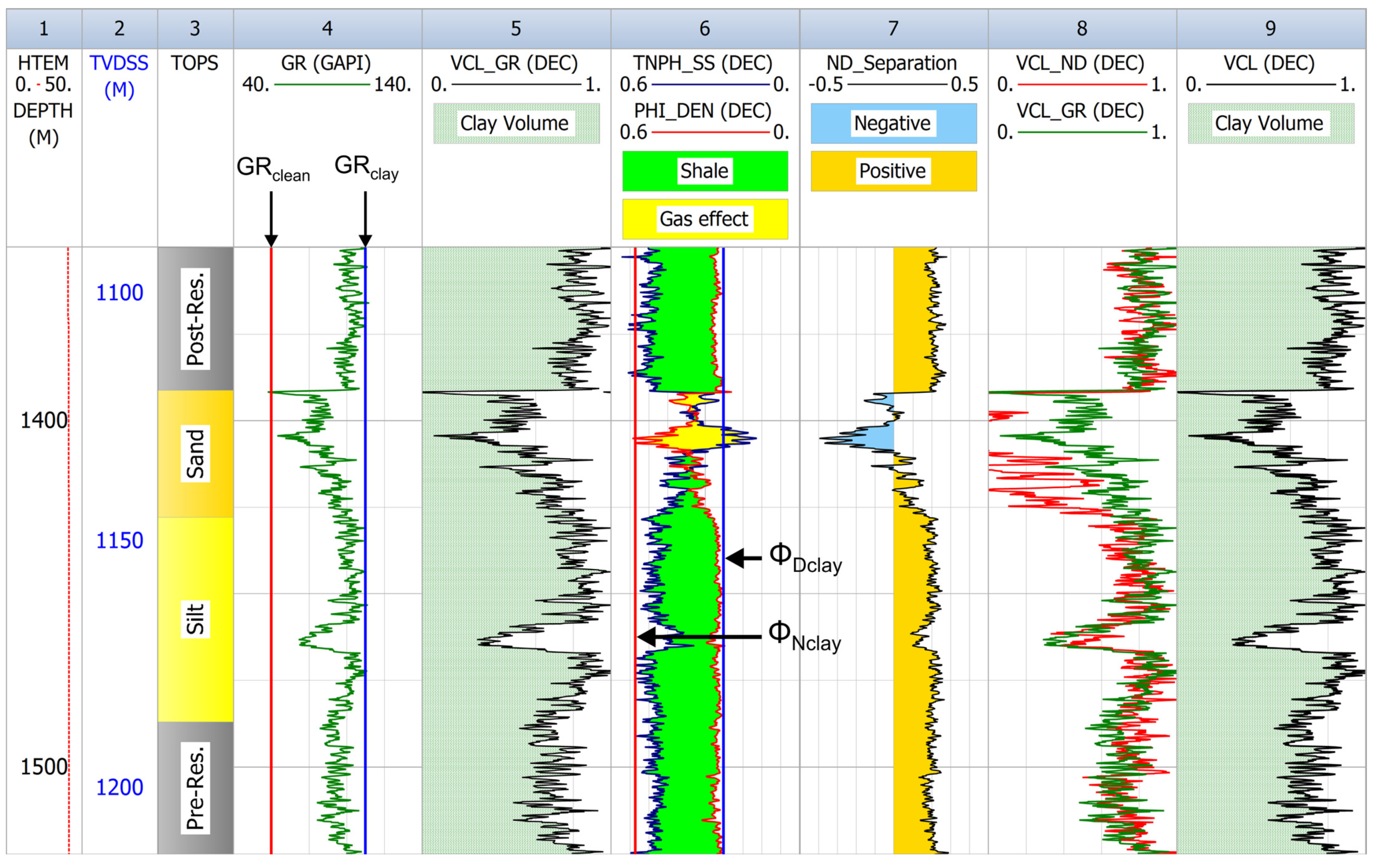
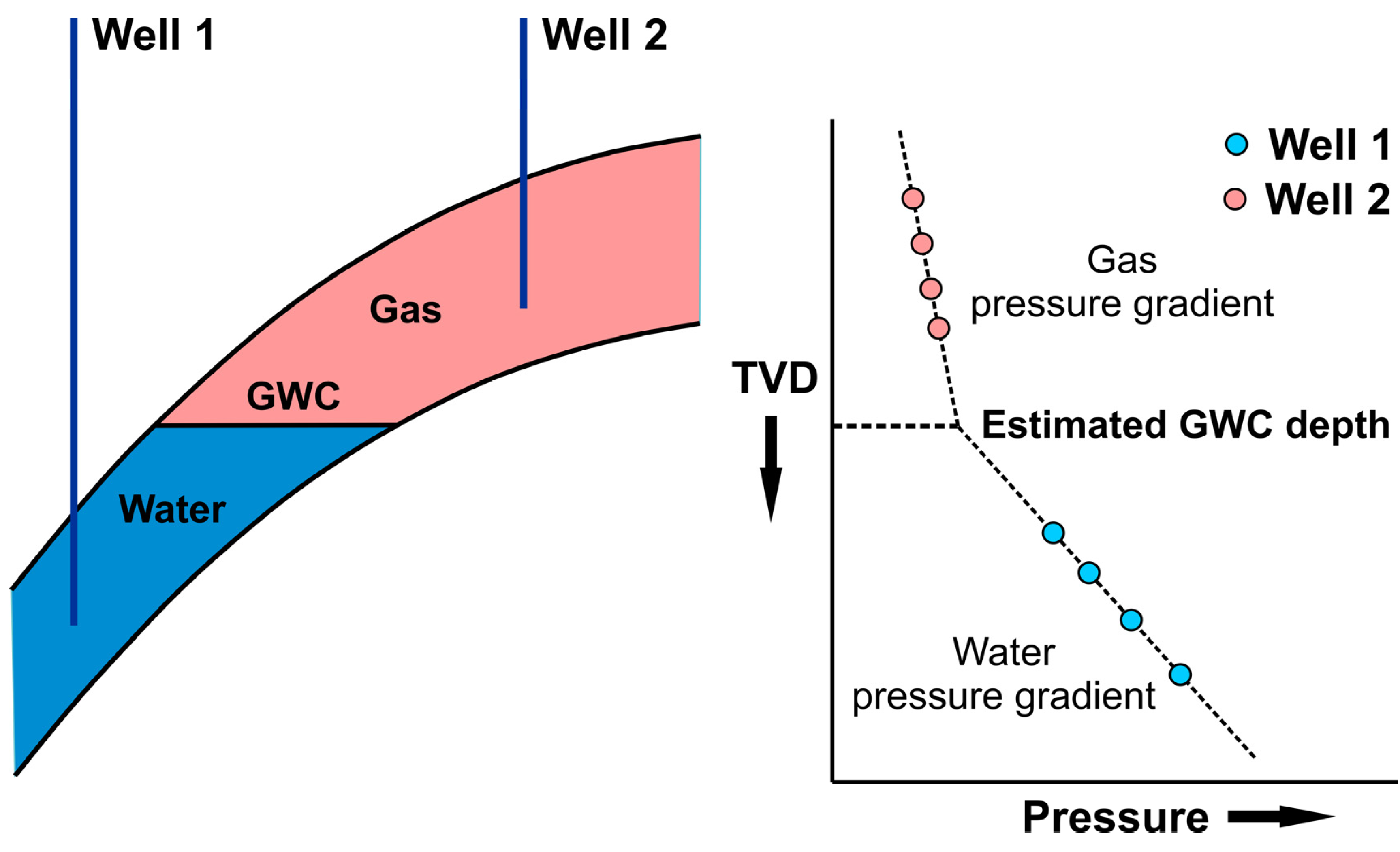
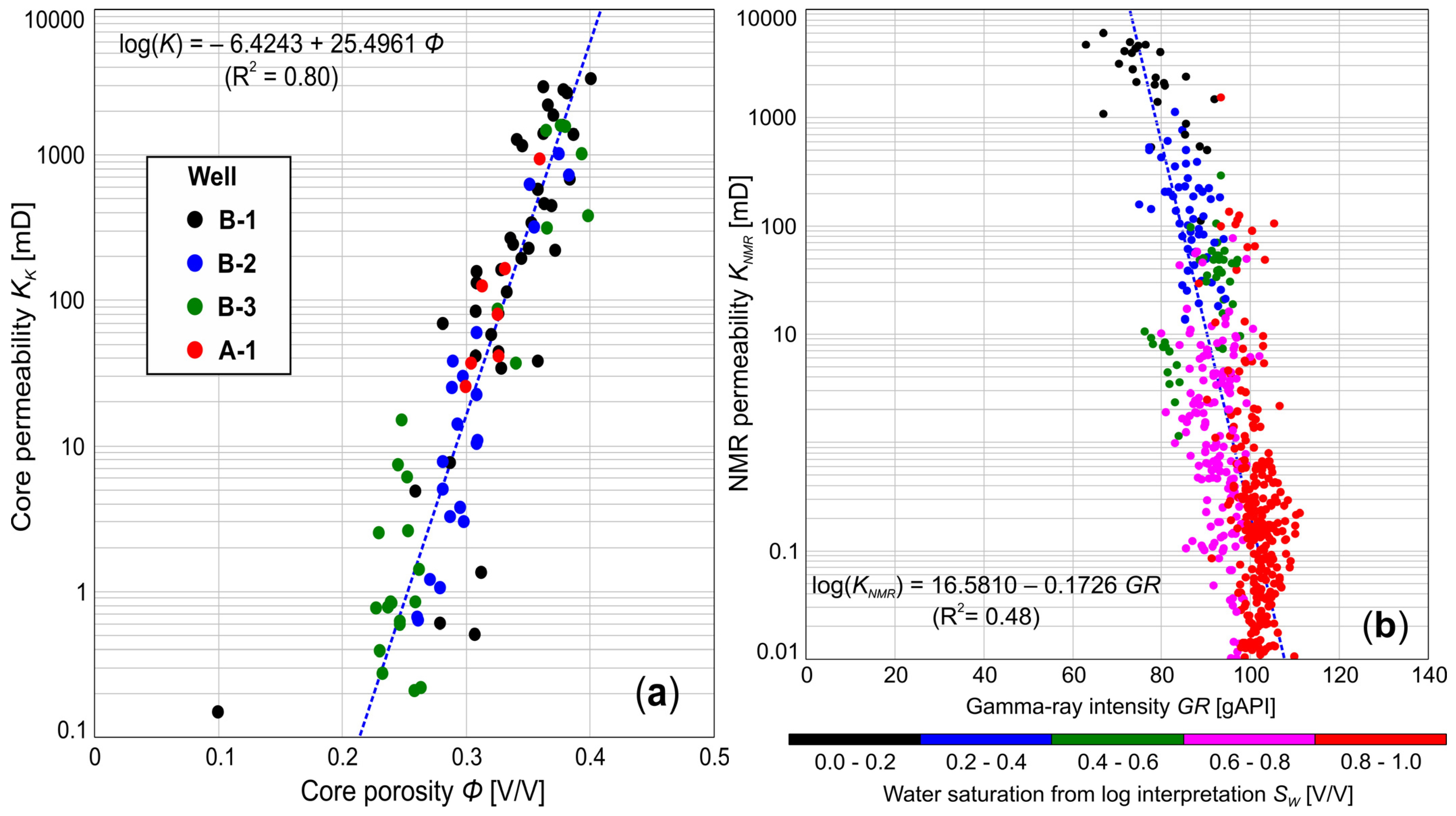


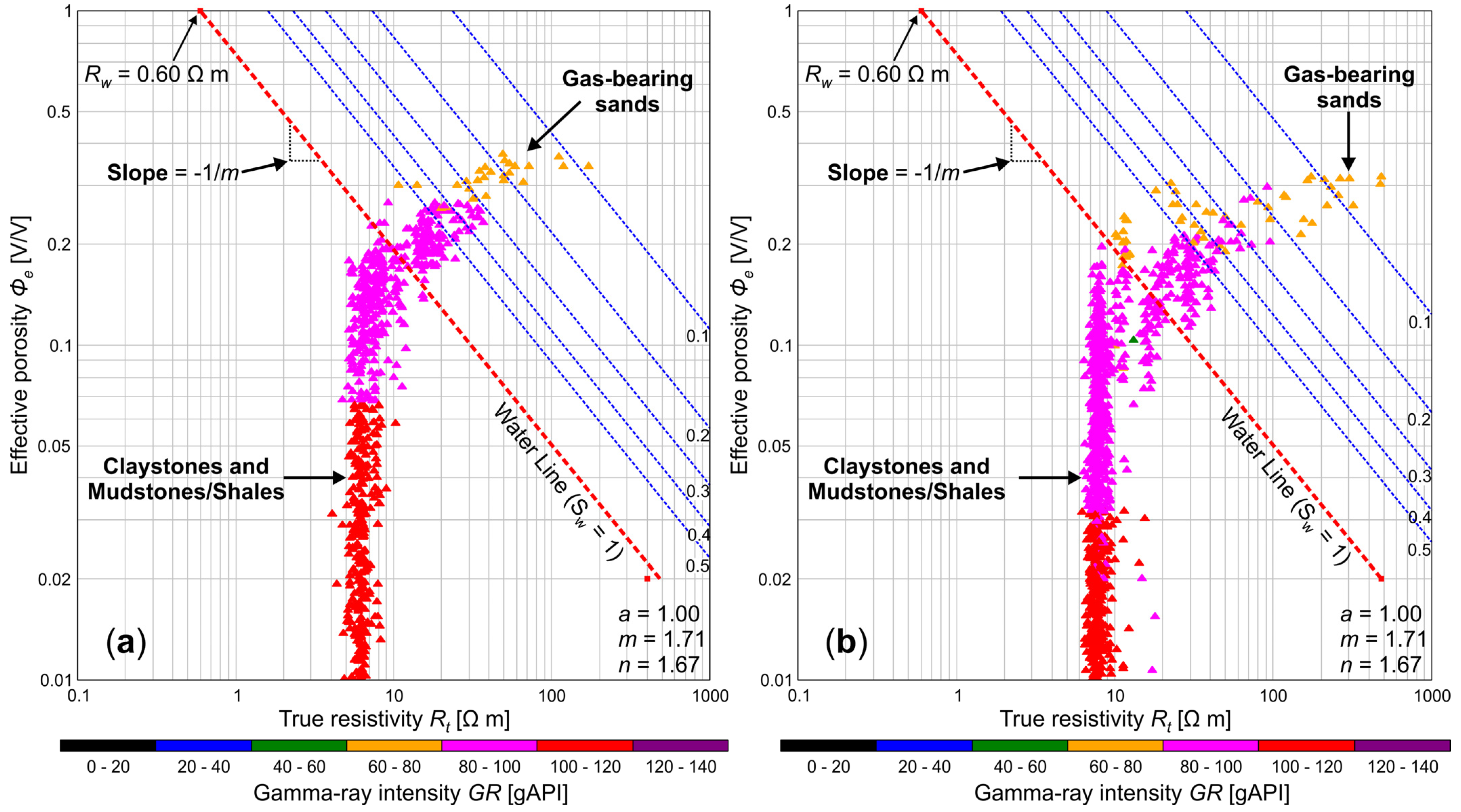



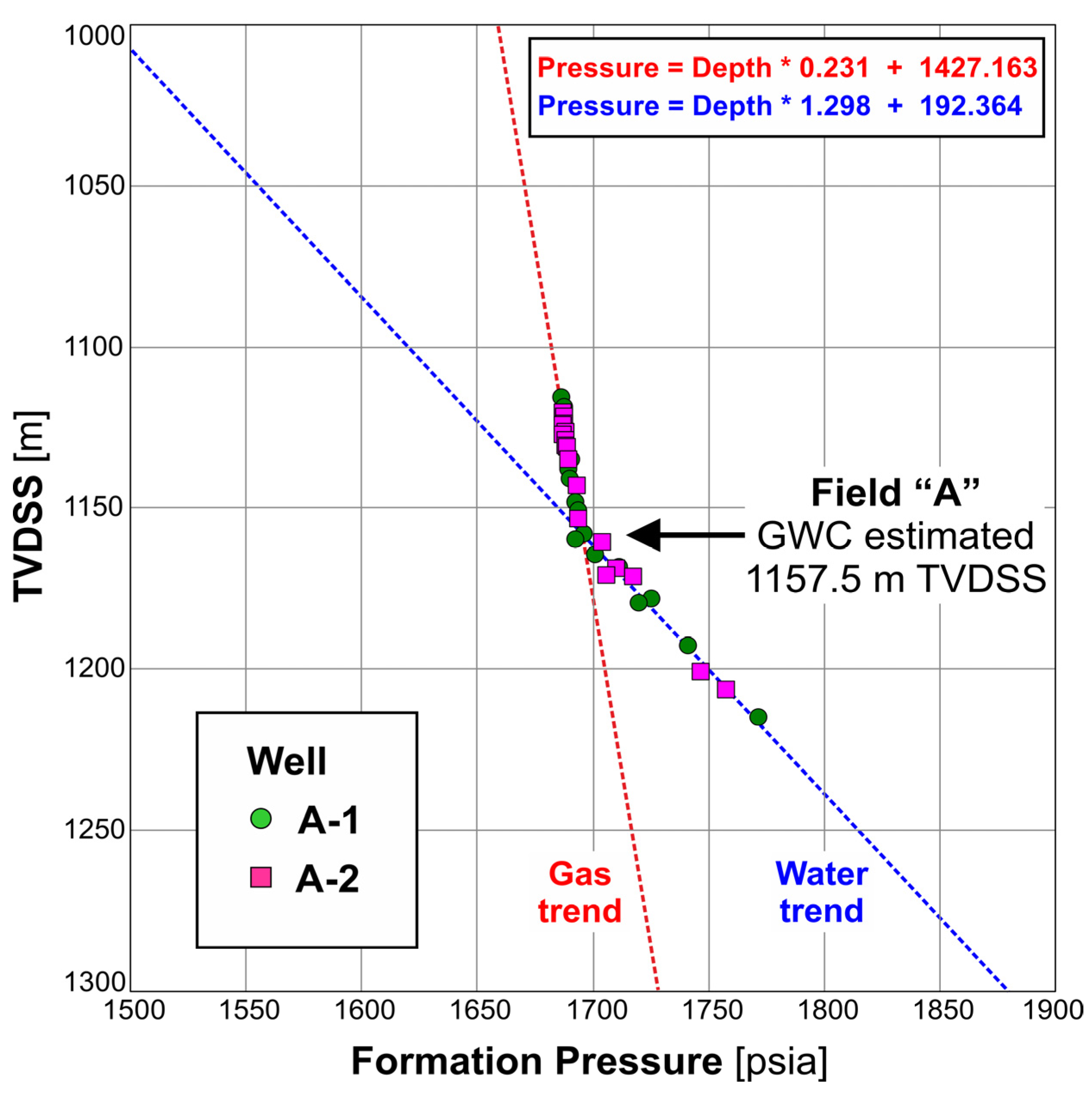
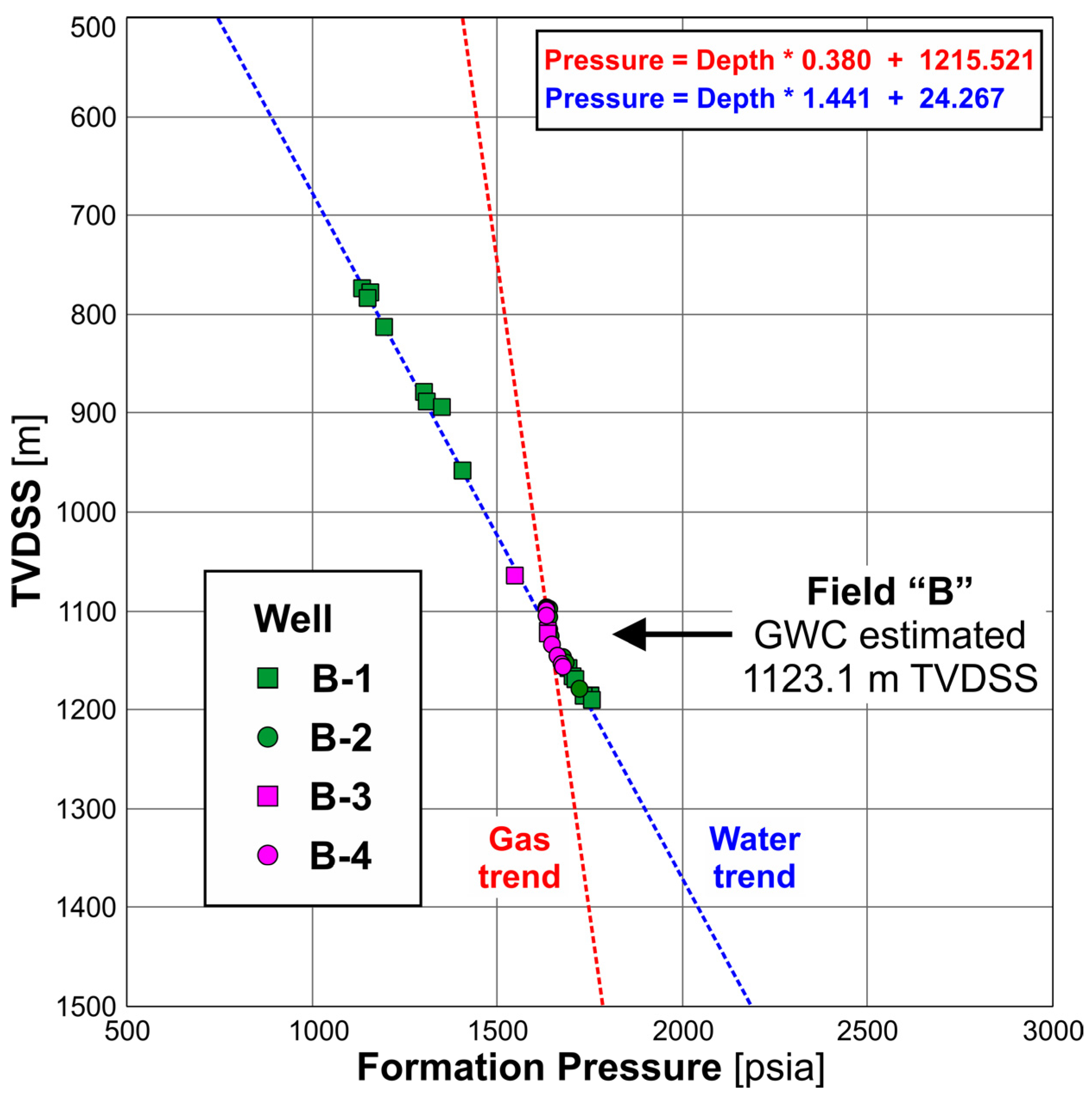
| Gas Field | Well | Number of Cores/Total Length [m] | Cored Intervals [m] | Petrophysical Analyses | Pressure Measurements Intervals [m] | Total Pressure Readings/Reservoir Pressure Readings |
|---|---|---|---|---|---|---|
| A | A-1 | 1/12.0 | 1140.0–1152.0 “Sand” | RCAL SCAL XRD | 1140.4–1240.0 “Sand”, Pre-reservoir | 19/17 |
| A-2 | N/A | N/A | N/A | 756.2–1515.0 Post-reservoir, “Sand”, “Silt”, Pre-reservoir | 28/16 | |
| B | B-1 | 3/27.5 | 1171.5–1199.0 Pre-reservoir | RCAL | 799.0–2487.5 Post-reservoir, Pre-reservoir | 18/0 |
| B-2 | 4/23.9 | 1125.5–1155.7 “Sand”, “Silt” | RCAL | 991.5–1264.0 Post-reservoir, “Sand”, Pre-reservoir | 17/4 | |
| B-3 | 8/52.2 | 1073.5–1154.0 Post-reservoir, “Sand”, “Silt” | RCAL SCAL XRD | 994.8–1228.7 Post-reservoir, “Sand”, Pre-reservoir | 7/2 | |
| B-4 | N/A | N/A | N/A | 1006.1–1222.2 Post-reservoir, “Sand”, “Silt”, Pre-reservoir | 14/6 |
| Well | Core ρma [g/cm3] | Core ϕ [V/V] | Core Kk [mD] | ||||||
|---|---|---|---|---|---|---|---|---|---|
| Minimum | Maximum | Mean | Minimum | Maximum | Mean | Minimum | Maximum | Mean | |
| A-1 | 2.65 | 2.73 | 2.68 | 0.299 | 0.359 | 0.322 | 25.7 | 935.0 | 201.9 |
| B-2 | 2.70 | 2.75 | 2.72 | 0.260 | 0.383 | 0.304 | 0.6 | 1019.0 | 139.7 |
| B-3 | 2.69 | 2.75 | 2.71 | 0.227 | 0.398 | 0.284 | 0.2 | 1611.0 | 261.8 |
| Well | Depth [m] | ϕ [V/V] | F | m | Sw [V/V] | IR | n |
|---|---|---|---|---|---|---|---|
| A-1 | 1143.20 | 0.359 | 5.54 | 1.67 | 0.132 | 38.85 | 1.81 |
| 1143.82 | 0.325 | 7.64 | 1.81 | 0.254 | 10.67 | 1.72 | |
| 1144.47 | 0.313 | 6.65 | 1.63 | 0.256 | 11.48 | 1.79 | |
| 1146.68 | 0.331 | 7.03 | 1.77 | 0.266 | 10.29 | 1.76 | |
| 1149.14 | 0.303 | 7.63 | 1.70 | 0.421 | 4.11 | 1.63 | |
| 1150.91 | 0.326 | 7.22 | 1.77 | 0.332 | 5.32 | 1.52 | |
| 1152.12 | 0.299 | 7.15 | 1.63 | 0.375 | 4.13 | 1.45 | |
| B-3 | 1140.72 | 0.251 | 8.57 | 1.56 | 0.590 | 1.90 | 1.22 |
| 1141.75 | 0.254 | 7.89 | 1.51 | 0.577 | 1.94 | 1.21 | |
| 1142.07 | 0.282 | 8.86 | 1.72 | 0.422 | 3.52 | 1.46 | |
| 1142.46 | 0.261 | 8.26 | 1.57 | 0.655 | 1.81 | 1.41 | |
| 1145.41 | 0.245 | 6.80 | 1.36 | 0.841 | 1.26 | 1.32 |
| Well | ρma [g/cm3] | ρmf [g/cm3] | ρh [g/cm3] | ρclay [g/cm3] | ϕNclay [V/V] | a | m | n | Rclay [Ω m] | Rw [Ω m] | Rmf @ Tmf [Ω m @ °C] |
|---|---|---|---|---|---|---|---|---|---|---|---|
| A-1 | 2.68 | 1.050 | 0.082 | 2.26 | 0.46 | 1 | 1.71 | 1.67 | 6.00 | 0.600 | 0.123 @ 12 |
| A-2 | 2.68 | 1.020 | 0.082 | 2.25 | 0.49 | 1 | 1.71 | 1.67 | 7.90 | 0.600 | 0.185 @ 25 |
| B-1 | 2.71 | 1.060 | 0.080 | 2.26 | 0.50 | 1 | 1.54 | 1.32 | 8.50 | 1.100 | 0.081 @ 18 |
| B-2 | 2.72 | 1.049 | 0.085 | 2.26 | 0.50 | 1 | 1.54 | 1.32 | 7.50 | 1.040 | 0.115 @ 17 |
| B-3 | 2.71 | 1.036 | 0.084 | 2.26 | 0.45 | 1 | 1.54 | 1.32 | 5.20 | 0.950 | 0.116 @ 25 |
| B-4 | 2.71 | 1.026 | 0.082 | 2.25 | 0.48 | 1 | 1.54 | 1.32 | 7.80 | 1.175 | 0.137 @ 28 |
| Well | Fluid 1 (Water) Pressure Trend [psia] [m TVDSS] | Fluid 1 (Water) Density [g/cm3] | Fluid 2 (Gas) Pressure Trend [psia] [m TVDSS] | Fluid 2 (Gas) Density [g/cm3] | GWC Estimated Depth [m TVDSS] |
|---|---|---|---|---|---|
| A-1 | Pressure = Depth ∙ 1.372 + 106.353 | 0.964 | Pressure = Depth ∙ 0.197 + 1465.902 | 0.139 | 1157.7 |
| A-2 | Pressure = Depth ∙ 1.227 + 275.749 | 0.863 | Pressure = Depth ∙ 0.304 + 1344.683 | 0.214 | 1158.4 |
| B-1 | Pressure = Depth ∙ 1.442 + 30.645 | 1.014 | N/A | N/A | N/A |
| B-2 | Pressure = Depth ∙ 1.444 + 18.131 | 1.015 | Pressure = Depth ∙ 0.090 + 1540.003 | 0.064 | 1124.4 |
| B-3 | Pressure = Depth ∙ 1.453 + 2.950 | 1.022 | N/A | N/A | N/A |
| B-4 | Pressure = Depth ∙ 1.451 + 0.798 | 1.020 | Pressure = Depth ∙ 0.230 + 1380.782 | 0.162 | 1130.3 |
Publisher’s Note: MDPI stays neutral with regard to jurisdictional claims in published maps and institutional affiliations. |
© 2021 by the authors. Licensee MDPI, Basel, Switzerland. This article is an open access article distributed under the terms and conditions of the Creative Commons Attribution (CC BY) license (https://creativecommons.org/licenses/by/4.0/).
Share and Cite
Niculescu, B.M.; Mocanu, V. Characterization of Pliocene Biogenic Gas Reservoirs from the Western Black Sea Shelf (Romanian Offshore) by Integration of Well Logs and Core Data. Energies 2021, 14, 6629. https://doi.org/10.3390/en14206629
Niculescu BM, Mocanu V. Characterization of Pliocene Biogenic Gas Reservoirs from the Western Black Sea Shelf (Romanian Offshore) by Integration of Well Logs and Core Data. Energies. 2021; 14(20):6629. https://doi.org/10.3390/en14206629
Chicago/Turabian StyleNiculescu, Bogdan Mihai, and Victor Mocanu. 2021. "Characterization of Pliocene Biogenic Gas Reservoirs from the Western Black Sea Shelf (Romanian Offshore) by Integration of Well Logs and Core Data" Energies 14, no. 20: 6629. https://doi.org/10.3390/en14206629
APA StyleNiculescu, B. M., & Mocanu, V. (2021). Characterization of Pliocene Biogenic Gas Reservoirs from the Western Black Sea Shelf (Romanian Offshore) by Integration of Well Logs and Core Data. Energies, 14(20), 6629. https://doi.org/10.3390/en14206629






